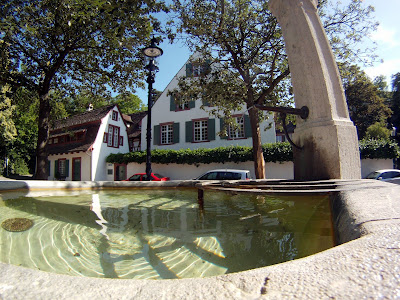 |
| 23-Jun-2012 |
Fountain at 23-Jun-2012 was plain. Sometime about October 2012, a decorative column was added, dated 1706.
 |
| 10-Nov-2012 |
 |
| 10-Nov-2012 |
 |
| 23-Jun-2012 |
 Location: St. Alban quarter 25 (go through a gate)
Location: St. Alban quarter 25 (go through a gate) 
 More Information
More Information Location: St. Alban quarter, in a niche at home 81 / adjacent walls suspended "Castellio-Weglein"
Location: St. Alban quarter, in a niche at home 81 / adjacent walls suspended "Castellio-Weglein" 
 More Information
More Information
 Location: St. Alban-Tal
Location: St. Alban-Tal 
 More Information
More Information  More Information
More Information 



 History / Description: The fountain has a large, rectangular pool and a Sudeltrog. The fountain column is crowned by a stone sculpture that resembles a castle. At the well site is also a Baslerstab dissuaded. Before 16th Century should have here again the fabulous castle "Wildegg" confessed. From 1820 to 1995 the building was used as Lohnhofs remand. With the opening of a new prison at Heuwaage which was hosted here superfluous. Today, in addition to apartments, a hotel, a collection of old musical instruments and facilities are located for cultural use.
History / Description: The fountain has a large, rectangular pool and a Sudeltrog. The fountain column is crowned by a stone sculpture that resembles a castle. At the well site is also a Baslerstab dissuaded. Before 16th Century should have here again the fabulous castle "Wildegg" confessed. From 1820 to 1995 the building was used as Lohnhofs remand. With the opening of a new prison at Heuwaage which was hosted here superfluous. Today, in addition to apartments, a hotel, a collection of old musical instruments and facilities are located for cultural use.  Location: Steinenvorstadt, before House 27
Location: Steinenvorstadt, before House 27 Special: With one exception - in Schwyz - were from 18 Century no more fountains crowned with standard-bearers in Switzerland.
Special: With one exception - in Schwyz - were from 18 Century no more fountains crowned with standard-bearers in Switzerland.
